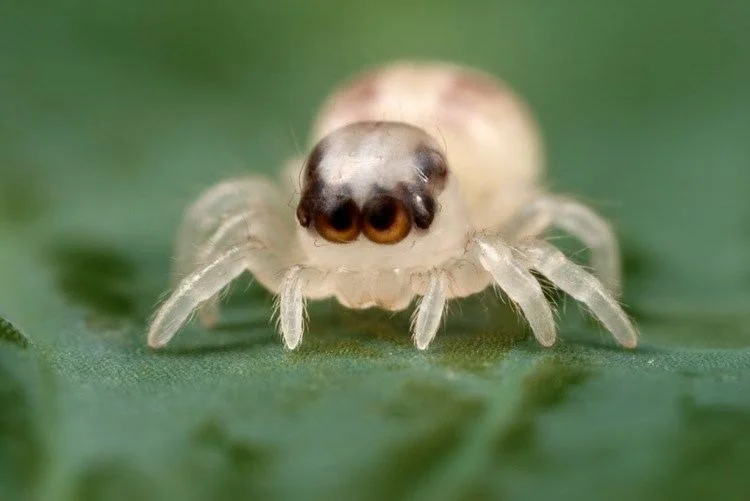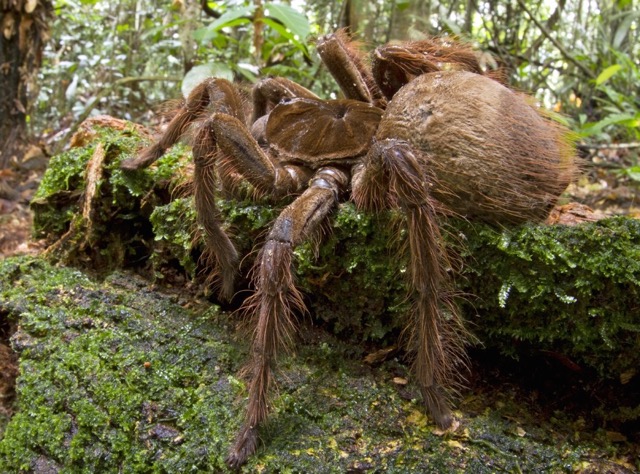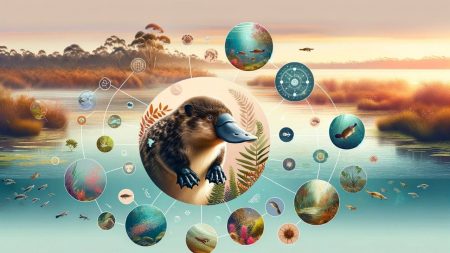Spiders are some of the most remarkable and diverse creatures on Earth, with over 45,000 species. While some species of spiders are harmless, others are venomous and even dangerous. In this article, we’ll uncover 32 awe-inspiring facts about spiders that will introduce you to the world of these fantastic eight-legged organisms.
They come in various shapes, sizes, colors, and habits; each species is adapted to survive in its unique environment. From astonishing silk production abilities to incredible hunting techniques and even some genuinely bizarre mating habits—spiders never cease to amaze. So buckle up, and let’s get ready to delve into the fascinating world of spider facts.
Spiders are arachnids with several unique characteristics, including:
- Eight legs equipped with sensory hairs
- A two-part body consisting of the cephalothorax and the abdomen, joined by a thin stalk called the pedicel
- Two or more eyes, depending on the species
- Four jaws are used for capturing and consuming prey, which lacks teeth and instead inject venom through their jaws
- Spinnerets, specialized organs used to produce silk for constructing webs and various other purposes
Table of Contents
- 1. Here are 32 fascinating facts about Spiders:
- 1. Spiders are arachnids, not insects.
- 2. Not all spider bites are deadly.
- 3. Spiders are most abundant in tropical regions, though they can be found on every continent except Antarctica.
- 4. The smallest spider species is the “Patu digua”, just 0.37 mm in length.
- 5. Goliath birdeater (Theraphosa blondi) is the world’s largest spider species.
- 6. All spiders produce silk.
- 7. Spider silk is stronger than steel and more flexible than nylon.
- 8. Spiders can detect vibrations in their surroundings.
- 9. Jumping spiders can jump up to 40 times their own body length.
- 10. Spiders use their webs to catch prey and as a means of communication.
- 11. Spiders have no wings or antennae.
- 12. The venom of some spiders, such as the Black Widow, can even cause paralysis in humans.
- 13. Orb-weaving spiders construct intricate webs with sticky threads that trap their prey.
- 14. Spiders have pale blue blood.
- 15. Female spiders are usually larger than males.
- 16. Most spiders have a very short lifespan, living only a few months or a few years at most.
- 17. Most spiders are considered beneficial to humans as they help control insect populations that could otherwise become pests.
- 18. Spiders are generally nocturnal animals, meaning they come out at night to hunt for food.
- 19. Trapdoor spiders have been called living fossils because of how similar they are to spiders from over 300 million years ago.
- 20. Spiders lack teeth and therefore rely on a liquid diet to survive.
- 2. More facts about Spiders:
- 21. Spiders can regenerate lost legs and sometimes even reproduce from lost limbs!
- 22. Not all spiders build webs; some hunt for their prey and others ambush them in burrows or crevices.
- 23. Most spiders are anti-social and do not live in colonies, but some species do live together in large groups.
- 24. Spiders have fangs that inject venom into their prey and paralyze them before eating them.
- 25. Spiders have an exoskeleton that hardens as they grow.
- 26. Some spiders can fly or glide short distances through the air thanks to strands of silk, known as ballooning.
- 27. Male spiders often have enlarged pedipalps which are used to transfer sperm to the female.
- 28. Spiders are carnivores who feed on other insects, like flies, moths, and grasshoppers.
- 29. Spiders use different types of webs such as orb webs, funnel webs, and tangle webs.
- 30. Spiders are able to sense changes in air pressure, which they use to find prey or predators nearby.
- 31. Some species of spiders are able to produce sound to attract mates or defend territory.
- 32. Spiders have sensory hairs on their bodies which help them detect movement.
- 3. Conclusion
Here are 32 fascinating facts about Spiders:
1. Spiders are arachnids, not insects.
They are a distinct class of invertebrates related to ticks, mites, and scorpions. They have segmented bodies, tough exoskeletons, and jointed appendages and lack jaws.
Most spiders have two distinct body regions – the cephalothorax and abdomen, and they inject digestive fluids into their prey before sucking its remains into their mouths.
Spiders also have chelicerae, pincer-like appendages used to catch prey, and pedipalps, which function as organs of touch.
2. Not all spider bites are deadly.
Some spider bites can be deadly, while others aren’t. Some spiders’ venom can cause humans to have allergic reactions, like skin rashes and difficulty breathing.
For example, brown recluse spider venom can cause skin rashes and difficulty breathing in humans, while black widow spider venom can cause abdominal pain and cramping.
In all cases, it is necessary to take the proper measures when encountering spiders and to look for medical assistance if you get bitten.
3. Spiders are most abundant in tropical regions, though they can be found on every continent except Antarctica.
They prosper more in these areas because the temperatures are higher and there is more diverse prey. Furthermore, an abundance of plants and more humid conditions give spiders more places to hide and spin webs. Also, the longer days of sunshine in tropical areas allow spiders to be active for extended periods, increasing their opportunities of finding food and reproduce.
4. The smallest spider species is the “Patu digua”, just 0.37 mm in length.
This species was discovered in Panama in 1999 and is part of the Patu family. It is tiny, even compared to other spiders, some of which can reach up to 4 cm in size. Despite their small size, they can still spin webs and capture prey.
They have been found living in plant residue and deep within soil crevices. Patu digua is an important species to study as it provides insight into the evolution and diversity of spider species.
5. Goliath birdeater (Theraphosa blondi) is the world’s largest spider species.
They are found in the tropical rainforests of northern South America. They have a leg span of up to 11 inches (28 centimeters) and a weight of over 6 ounces (170 grams).
The Goliath birdeater derives its name from being both large in size and having a diet that consists of birds and insects.
What makes this spider special is its powerful jaws, which can deliver a painful bite, and its ability to produce audible hissing noises when feeling threatened. Additionally, the Goliath birdeater can shoot silk from their spinnerets.
6. All spiders produce silk.
Their spinnerets secrete proteins from glands called spinning glands, which form silk. This silk can wrap and immobilize prey, construct intricate webs, or create a retreat.
These webs are highly effective at trapping flying insects, allowing the spider to feed without expending energy on hunting.
7. Spider silk is stronger than steel and more flexible than nylon.

This is one of the most fascinating but shocking facts about spiders. Spider silk is five times stronger than steel on a weight-by-weight basis, yet it is finer than human hair.
This makes it more resilient than any synthetic fiber, including nylon. That’s why spider silk has been used to make parachutes, medical sutures, bulletproof vests, and even fabrics for clothing. It is a truly remarkable material that continues to prove its worth in various industries.
8. Spiders can detect vibrations in their surroundings.
They have specialized sensory organs known as slit sensillae located on their legs. They can detect even the slightest vibrations, such as those created by an insect moving nearby.
When a spider detects a vibration, it will investigate further, often using its web to capture its prey. This vibration-sensing ability helps spiders to locate and capture their prey quickly and efficiently.
Some spiders also use their webs to sense when prey is nearby. When an insect touches the web, it sends vibrations through the web that the spider can detect.
9. Jumping spiders can jump up to 40 times their own body length.
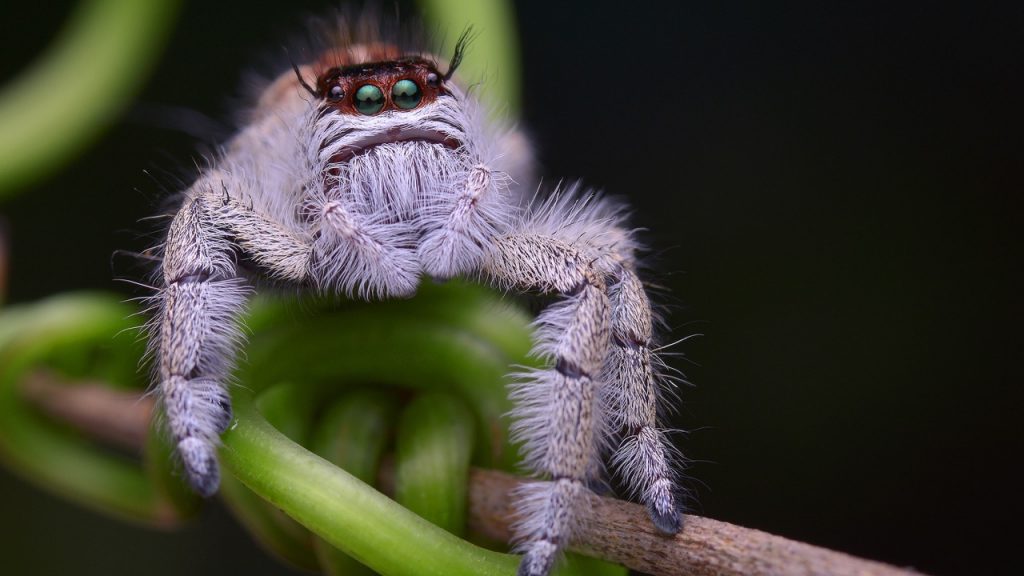
This impressive ability is enabled by their semi-hydraulic muscle system, which allows them to vary their muscle length and body size or mass.
Simply put, they use their powerful rear legs to launch themselves into the air with great strength and accuracy.
They are remarkably diverse in tropical regions but also occur in areas ranging from deserts to mountain forests.
Despite their small size, jumping spiders have one of the best visions among arthropods. They can precisely target their prey with their well-developed anterior median eyes.
10. Spiders use their webs to catch prey and as a means of communication.
A new study has discovered that orb-weaving spiders use their webs to detect vibrations, allowing them to coordinate attacks and sense their environment.
These vibrations can also be used to communicate with other spiders, forming rudimentary communication in their own “language” of web vibrations.
Furthermore, spiders can violently shake their webs as a form of defense. Webs also provide spiders with a passive web for bugs to fly into, making it an efficient hunting method. This work may one day lead to a means of communication with spiders in their own language.
11. Spiders have no wings or antennae.
Unlike insects, spiders don’t use their antennae to sense changes in air pressure or prey. Instead, they rely on the sensory organs on their legs and abdomen to detect and respond to environmental stimuli. These organs are sensitive to temperature, touch, and chemicals in the air and on surfaces.
Spiders also have no wings and cannot fly like some insects. Therefore they rely on other methods of movement, such as walking, climbing, or jumping.
Spiders also use their silk as a form of transportation by ballooning; spiders attach a single strand of silk and catch the wind to move from one location to another.
12. The venom of some spiders, such as the Black Widow, can even cause paralysis in humans.
The neurotoxin latrotoxin, present in venom, causes latrodectism. Symptoms of this condition include intense muscle pain and spasms, nausea, vomiting, fainting, dizziness, and weakness.
In extreme cases, paralysis of particular body parts may occur. Fortunately, medical attention is available to treat the symptoms; in most cases, the effects are reversible.
13. Orb-weaving spiders construct intricate webs with sticky threads that trap their prey.
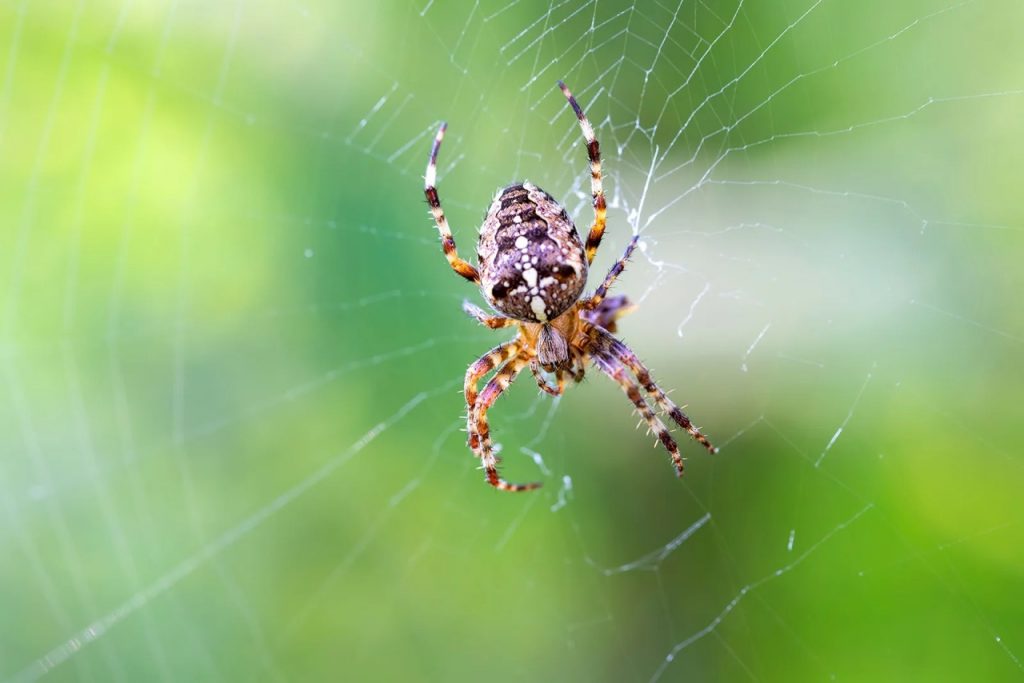
This ability of orb-weaving spiders to build webs is impressive, mainly because they are much smaller than their prey.
They construct intricate webs with sticky threads, which act as traps for their prey. These webs are composed of several elements: predatory capture threads, stabilimenta threads, and a radial pattern of sticky capture threads.
These capture threads are made up of liquid silk that dries upon contact with the air, trapping any insects that come in contact with it.
Some spiders, such as those in the Theridiosomatidae family, even build conical webs which can launch the spider at nearby prey like a slingshot.
14. Spiders have pale blue blood.
Spiders have pale blue blood because their blood contains a compound called hemocyanin.
This compound binds to oxygen and carries it around the body, unlike hemoglobin which contains iron and is used by mammals, including humans.
Hemocyanin has an atom of copper in its structure, which absorbs all colors of light except blue, causing its blood to appear blue.
Read More: 30 Surprising Facts About Fingernails – You Won’t Believe #13!
15. Female spiders are usually larger than males.
This is one of the most fascinating facts about spiders. This size difference can be attributed to the fact that females can lay hundreds of eggs in a sac or nest at once. This requires a larger body size, as the female needs to carry and lay the eggs.
A study published in BMC Evolutionary Biology found that smaller males are better at bridging when spiders use the wind to carry a strand of web to their destination and then clamber upside down along the resulting bridge.
This allows them to access more mating opportunities and thus be more competitive in reaching receptive females.
As such, there is a selective pressure for males to be smaller. However, the larger body size of females still confers them an advantage in terms of generating offspring.
16. Most spiders have a very short lifespan, living only a few months or a few years at most.
This is due to their highly specialized diet and lifestyle. Spiders eat small insects, such as flies, beetles, moths, and other arthropods.
As they feed on these insects, they also consume the toxins in their prey, which can shorten their lifespan significantly.
Spiders are also very vulnerable to predation, often falling victim to birds and other predatory animals.
Common house spiders, on average, live for about one year. Spiderlings, baby spiders that hatch from an egg sac, can survive for up to 30-60 days without food.
Adult spiders can live without food for up to six months but generally die sooner if they do not have a regular food source.
17. Most spiders are considered beneficial to humans as they help control insect populations that could otherwise become pests.
Spiders serve as a natural controller of insect pests. They play an integral role in limiting the populations of many insects that could otherwise destroy crops and food sources.
If it weren’t for spiders, these insect populations might get out of hand and cause severe damage. In addition, some spiders use biological control to reduce pests, making them less harmful.
That’s why scientists urge us not to kill spiders because they are so beneficial for our ecosystem and help manage the number of bugs that ruin plants and crops.
18. Spiders are generally nocturnal animals, meaning they come out at night to hunt for food.
This behavior is typical among many species of spiders, as their poor eyesight makes it difficult to find prey during the day.
At night, spiders rely on their hearing and sense of touch to sense the movements of potential prey like small mammals, insects, and other arthropods.
Nocturnal behavior also helps spiders avoid the heat of the day and competition from other predators.
As a result, spiders are most active at night, when they can take advantage of their superior senses and reduce competition to find food.
19. Trapdoor spiders have been called living fossils because of how similar they are to spiders from over 300 million years ago.
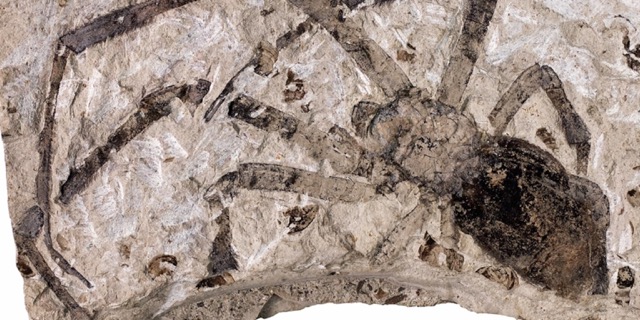
This is because these spiders have evolved very little over time, with their morphological features and behaviors remaining largely unchanged.
One example of this is Cryptocteniza kawtak, a new genus and species of trapdoor spider that was recently discovered in a limited area in California’s Moss Landing State Beach.
This species was identified by Jason Bond, Ph.D., who noted its unique mating structures and trapdoors.
The discovery of this spider also emphasizes its precarious position, as it is an endangered living fossil due to its age, narrow distribution, and distinctness. To protect this species, Bond recommends a formal population survey and careful habitat restoration.
20. Spiders lack teeth and therefore rely on a liquid diet to survive.
They inject digestive juices into their captured prey to break it down and then suck up the liquefied creature. This process is known as “slurping up the goodness” and is used by both wandering and web-building spiders.
Wandering spiders have muscular, solid legs, modified feet, and two large eyes that help them to hunt and jump on their prey.
Web-building spiders have small eyes and thinner, more agile legs, which help them hang on the webs they build and wait for their food.
The venom of spiders is stored in pieces in their salivary glands and is used to subdue and digest their prey.
The chelicerae (mouth parts) of most hunting spiders are serrated, allowing them to tear apart and shred their food. After liquefying the prey with venom, spiders then use their sucking stomach to draw in the liquid remains.
More facts about Spiders:
21. Spiders can regenerate lost legs and sometimes even reproduce from lost limbs!
This ability is often associated with molting when the spider sheds its old exoskeleton and grows a new one. During this process, the spider can regrow or regenerate its lost legs.
Amazingly, garden cross spiders can regenerate lost legs and use them immediately to build a pitch-perfect web. Not only does the shedding allow for growth, but it also allows for regeneration.
If a spider is unfortunate enough to lose a leg, provided it still has enough legs to move, it can reproduce from the lost limb.
Even if the spider is missing up to three legs, it can still recover a surprising degree of mobility by learning to persevere.
Such regeneration seems to be an ancestral trait and has enabled spiders to survive despite their losses.
22. Not all spiders build webs; some hunt for their prey and others ambush them in burrows or crevices.
Some spiders, such as wolf spiders, crab spiders, and trapdoor spiders, actively hunt for their prey by stalking them or ambushing them from a hidden burrow or crevice.
These ambush hunters wait in a protected area at the base of their burrows or camouflaged in vegetation and strike when their prey gets too close.
Sticky silk traps in webs are also used by some spiders to catch their prey. They also lure web-building spiders by mimicking trapped insects. In addition, they may ambush their prey by catching them completely unawares.
Some Portia spiders also hunt for their prey in burrows or crevices, while others may attack and eat other members of their own species.
23. Most spiders are anti-social and do not live in colonies, but some species do live together in large groups.
Most spiders are anti-social and prefer to hunt alone and vigorously defend their webs from other spiders. They often go to great lengths to hide from potential predators and prey, spinning webs in isolated corners or attaching or attracting natural materials to their bodies for camouflage.
This behavior is an evolutionary adaptation, as it increases the survival rate of the spider by reducing the risk of being eaten or disturbed while hunting. Social behavior among spiders varies, ranging from precarious toleration to cooperative hunting and food-sharing.
Most spiders live for only two years and focus their energy on survival rather than socializing. However, a few species have evolved to live in groups, forming colonies of up to 50000 individuals.
For example, Anelosimus eximius is a social spider species that produces large populations over time and builds communal webs. These spiders can take advantage of larger prey and bigger nests than solitary species.
Subsocial spiders live together for extended periods, but social spiders are more cooperative and “tolerate” strangers. This behavior is uncommon among spiders, making it an interesting phenomenon.
24. Spiders have fangs that inject venom into their prey and paralyze them before eating them.
The venom comprises digestive enzymes and neurotoxins, which work together to immobilize the prey. This venom is injected through the spider’s fangs, which are specially adapted for this purpose.
The paralyzing venom is injected first, rendering the prey immobile, and the digestive enzymes then liquefy the prey’s insides.
Once the prey has been immobilized, the spider will use its appendages to grab onto it and then inject a dose of venom to paralyze it.
The spider will then secrete digestive enzymes to liquefy the prey, allowing it to consume it. Some spiders use their venom economically by adapting the amount injected depending on the size of the prey.
Read More: 51 Mind-Blowing Facts About the English Language That You Must Know
25. Spiders have an exoskeleton that hardens as they grow.
The spider’s exoskeleton is made of several cuticle layers, a composite material containing various proteins and chitin. As the spider grows, it must form a new, larger cuticle exoskeleton and shed its old one, known as molting.
When molting, the spider secretes a molting fluid between the old exoskeleton and the new one, which helps to separate the two. After molting, the new exoskeleton is typically folded and very soft to expand as the cuticle material hardens.
This exoskeleton protects the spider and also helps to regulate water and gas exchange between the spider and its environment. It is incredibly strong and resilient yet light enough to allow the spider to move and hunt easily.
26. Some spiders can fly or glide short distances through the air thanks to strands of silk, known as ballooning.

Ballooning occurs when spiders release strands of silk into the air that are caught by the wind and propel them aloft.
It is believed that the negative electric charge of the spider silk threads helps them to move by providing an upward pull on the strands.
For years, this method of dispersal has been noted, even on volcanic islands where spiders are some of the first animals to recolonize the land post-eruption.
Some spiders have adapted themselves to ballooning, due to their adaptation to living in trees, to reach their destination.
Also, spider ballooning has been seen on dandelions, which demonstrates the incredible ability of these creatures to move through the air.
27. Male spiders often have enlarged pedipalps which are used to transfer sperm to the female.
The appendages located at the end of the pedipalp are used for storing, transferring, and assessing the female during mating. During mating, the male spider moves his pedipalps, which allows him to transfer the sperm packet to the female’s epigynum.
The female spider then stores this packet in a pocket and uses it to fertilize her eggs. Only adult male spiders have fully developed pedipalps, making them useful for mating. It’s pretty amazing how such tiny creatures can use such complex organs to transfer their sperm!
28. Spiders are carnivores who feed on other insects, like flies, moths, and grasshoppers.
The larger spiders have a more varied diet, including amphibians and lizards. This fact is supported by a study that reveals that spiders consume between 400 and 800 million tons of food annually.
In addition to insects, spiders feed on other invertebrates, such as earthworms and snails. Other predatory animals, such as lady beetles, ground beetles, rove beetles, flower bugs, and other predatory true bugs, lacewings, and hoverflies, are also important predators of insects.
29. Spiders use different types of webs such as orb webs, funnel webs, and tangle webs.
Orb webs are the most recognizable type of webs spun by spiders. Orb weavers, which belong to the Araneidae family, create large vertical webs that spiral outward using thin strands, similar to spokes on a wheel.
These webs are sticky and have spokes radiating from the center, with a spiral pattern of sticky silk running along the spokes. The spider will then sit at the center of the web in order to detect any vibrations that may indicate an insect has become entangled in its web.
Funnel webs are another type of web spun by spiders, typically with a wide flat sheet connected to a narrow funnel-like tube. These webs are usually used by spiders to hide while they wait for prey, and then they quickly dart out of the funnel to capture their prey.
Finally, tangle webs are a type of web used mainly by spiders in the Desidae family. These webs are made up of a tangle of sticky threads designed to catch prey as it falls into the web. As the prey struggles to break free from the web, it alerts the spider, which then quickly wraps up its meal.
In conclusion, spiders use various types of webs for different purposes. Orb webs are used to capture prey, funnel webs are used as hideouts, and tangle webs are used to trap unsuspecting prey.
The different types of webs spun by spiders demonstrate their incredible adaptability and resourcefulness.
30. Spiders are able to sense changes in air pressure, which they use to find prey or predators nearby.
This ability is essential for the spider’s survival and is achieved through various methods. Firstly, spiders have chemoreceptors (taste receptors) located on their feet, which allow them to sense chemicals that predators unintentionally release into the environment.
Additionally, spiders have hairs on their legs that can detect vibrations caused by prey, predators, or courting partners. Through this, they can determine whether or not to put up their “sails.”
Finally, some species of spiders can detect changes in air pressure by using vision to see prey or predators in the air, water, or ground. Through these methods, spiders can detect changes in air pressure and use this to detect prey or predators in the area.
31. Some species of spiders are able to produce sound to attract mates or defend territory.
This sound is produced by the vibration of the spider’s abdomen. This process is known as the ‘stridulatory mechanism.’ It occurs when the spider rubs its spinnerets and setae together, which creates a sound that other spiders can hear.
The sound production capabilities of spiders vary between species. Some spiders, such as the Cupiennius salei, have specialized organs that allow them to produce more complex sounds.
These organs are located in the abdomen and vibrate when the spider rubs its legs together. Other species may rely on their environment to amplify the sound they produce.
For example, male spiders of the genus Neoscona can use surrounding dried leaves to create a low buzzing sound.
In addition to sound production, spiders can also sense vibrations from their environment. This sensitivity is finely tuned and allows them to distinguish between different types of prey, such as a moth, hitting their webs.
The spider’s web also helps to transmit vibrations across a wide range of frequencies so that when plucked like a guitar string, its sound carries information about the spider’s habitat and behavior.
The sound production capabilities of spiders are fascinating and offer insight into the evolution of communication in animals.
Scientists are continuing to explore these abilities and have recently found that spiders respond to sounds played near their webs. This discovery could have implications for improving microphones and other technological applications.
32. Spiders have sensory hairs on their bodies which help them detect movement.
Spiders have a variety of sensory hairs on their bodies which help them to detect movement. These hairs, known as trichobothria, are located across their legs and body, and are extremely sensitive to air currents and vibrations.
This enables them to sense subtle air movement, as well as vibrations created by nearby objects. The trichobothria are also used in interactions ranging from mating to prey, as they help the spider to move freely about its terrain.
Slit sense organs are also present in the form of minute hairs which provide additional sensitivity to air movement. The spider’s sensitivity to the environment is so great that it has been known to pick up air movements even from a distance.
In addition, recordings of action potentials from spider tactile hairs and trichobothria have shown neurons that are normally silent, signaling brief touching or vibration. Finally, dense hair on its body helps it to sense its environment by providing additional tactile feedback.
Conclusion
When it comes to spiders, there is so much to discover that this article can barely contain it all. Spiders are:
- Creatures of fear and amazement
- Cultural symbols of prophecy
- A source of fascination for the ages
Spiders may be some of the most misunderstood creatures on Earth, but they certainly aren’t short of facts that make us wonder. In conclusion, spiders are fascinating creatures with unique capabilities and behaviors. Their webs range from simple to complex designs, and they produce silk of remarkable strength. They can also sense vibrations in their web, allowing them to capture prey they can’t see. Knowing more about them can help us appreciate what these eight-legged creatures bring to our lives.
References:
- “Spider | Description, Behavior, Species, Classification, and Facts.” Encyclopedia Britannica, www.britannica.com/animal/spider-arachnid.
- Stevens, A. P. (2022, June 15). Orb-weaving spiders use their webs like external eardrums. Science News Explores. https://www.snexplores.org/article/orb-weaving-spiders-use-their-webs-like-external-eardrums
- Snails, Spiders, and Octopi all have Blue Blood. (n.d.). Office for Science and Society. https://www.mcgill.ca/oss/article/did-you-know/snails-spiders-and-octupi-all-have-blue-blood
- Why are male spiders small while females are giant? (n.d.). ScienceDaily.
- Beneficial spiders in the landscape: #22 General Overview of Spiders. (n.d.).
- Today, E. (2021, January 8). Shut the Front Door! Researchers Find ‘Endangered Living Fossil’ Trapdoor Spider. Entomology Today.
- Spider, I., & Spider, I. (2016, January 19). How Spiders Eat. The Infinite Spider. https://infinitespider.com/how-spiders-eat/
- “How Long Do Spiders Live – Spider Life Cycle and Lifespan.” Earthkind, 19 Sept. 2017, www.earthkind.com/blog/long-spiders-live-exploring-spider-life-cycle
- Luo, C., & Wei, C. (2015). Stridulatory Sound-Production and Its Function in Females of the Cicada Subpsaltria yangi. PLoS ONE, 10(2).
Read More Articles:
- Are Dolphins Evil? 12 Reasons Why We Think So!
- 30 Amazing Animal Superpowers That You Wish You Had
- Everything About Finger Monkey aka Pocket Monkey (Pygmy Marmoset)
- 14 Amazing Facts about Butterflies You Never Knew


